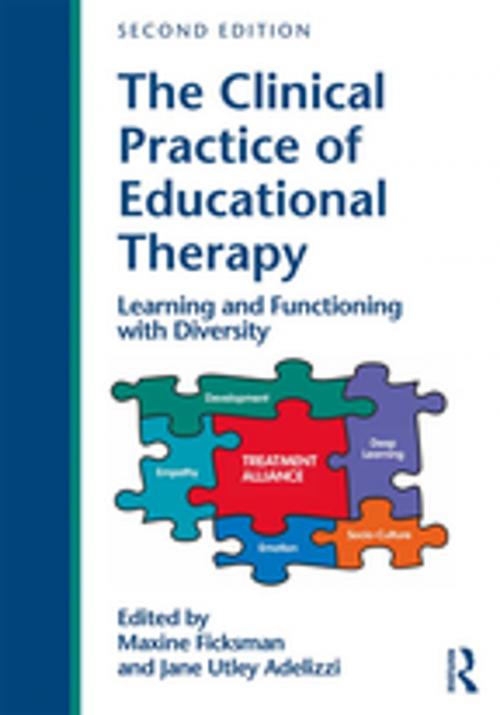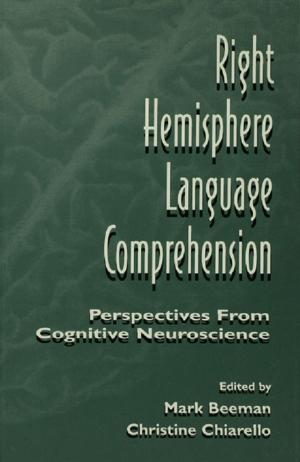The Clinical Practice of Educational Therapy
Learning and Functioning with Diversity
Nonfiction, Reference & Language, Education & Teaching, Educational Theory, Educational Psychology, Counseling & Guidance, Special Education| Author: | ISBN: | 9781315283357 | |
| Publisher: | Taylor and Francis | Publication: | September 1, 2017 |
| Imprint: | Routledge | Language: | English |
| Author: | |
| ISBN: | 9781315283357 |
| Publisher: | Taylor and Francis |
| Publication: | September 1, 2017 |
| Imprint: | Routledge |
| Language: | English |
Despite the wide array of services offered to students with learning disabilities, attention-deficit disorder, and a variety of comorbid conditions, large numbers of students are caught in the struggle of surviving school. Unfortunate school experiences may impact their sense of self and the degree of tenacity with which they pursue further training or challenging opportunities in the workplace. These are the people for whom educational therapy provides relief, enlightenment, and the coveted prize of success.
The second edition of *The Clinical Practice of Educational Therapy, *the first textbook in its field, provides a comprehensive perspective of this interdisciplinary profession and practice, reaching out to a more global audience. The book describes the scope and practice of educational therapy from its European roots to its growing presence in the United States, providing readers with case studies and research that illustrate the work of educational therapists across the lifespan in diverse settings.
Interdisciplinary Perspective — Other books focus on either educational or therapeutic interventions but rarely discuss the blend and synergy of disciplines (e.g., special education, neuropsychology, assessment, and social work) that are the hallmark of this unique profession.
Illustrative Cases — The text draws heavily on case studies as a means of understanding the practice of educational therapy, especially the dynamic relationship that exists between therapist and client. Numerous charts and tables provide visuals for educational therapists as well as allied professionals, parents, and those with learning challenges.
Expertise — The editors are both highly visible educational therapists. Chapter authors are either experienced educational therapists or allied professionals who have made scholarly contributions to the profession, such as Trisha Waters, Roslyn Arnold, and George McCloskey.
In addition to benefiting educational therapists and students, this book is appropriate for professionals who work in related fields such as special education, regular education, school and educational psychology, neuropsychology, school counseling, psychology, speech and language pathology, art therapy, occupational therapy, and social work, as well as in medicine and psychiatry.
NEW TO THE SECOND EDITION
The second edition of The Clinical Practice of Educational Therapy: Learning & Functioning with Diversity has revised and updated the chapters from the first edition, and added three new chapters which further define and broaden this field by exploring diverse perspectives:
- Chapter 10, "Cultivating Character Development: Educational Therapy’s Impact on Individuals, Families, Schools, Educational Policy, and Society" by Maxine Ficksman
- Chapter 12, "Women and Girls Who Are Disenfranchised: A Global and Interdisciplinary Approach to Educational Therapy" by Jane Utley Adelizzi
- Chapter 17, "Examining the Efficacy of Graduate Programs in Educational Therapy at California State University, Northridge (CSUN): Educational Therapy Intern, Graduate and Parent Perspectives" by Marcy Dann, Nancy Burstein, Tamarah Ashton, and Sue Sears.
These additional chapters, supported by brain-based research, characterize the shifts and changes experienced in a range of settings. Through the treatment alliance, educational therapists address students’ and clients’ ability to experience a more comprehensive model of learning, dependent upon the psychological, social, emotional, cultural and academic environments. The three new chapters range in focus from formal research and graduate training in the field of educational therapy to students throughout the lifespan whose social and educational experiences require a careful eye to not only the academic task at hand but also to the ways in which they cope and adapt to a range of environments and challenges. Lastly, educational therapy’s empathic foundation in practice is exemplified when we consider the global experience of students who strive to learn in situations and settings that threaten their survival and disenfranchisement from society.
Despite the wide array of services offered to students with learning disabilities, attention-deficit disorder, and a variety of comorbid conditions, large numbers of students are caught in the struggle of surviving school. Unfortunate school experiences may impact their sense of self and the degree of tenacity with which they pursue further training or challenging opportunities in the workplace. These are the people for whom educational therapy provides relief, enlightenment, and the coveted prize of success.
The second edition of *The Clinical Practice of Educational Therapy, *the first textbook in its field, provides a comprehensive perspective of this interdisciplinary profession and practice, reaching out to a more global audience. The book describes the scope and practice of educational therapy from its European roots to its growing presence in the United States, providing readers with case studies and research that illustrate the work of educational therapists across the lifespan in diverse settings.
Interdisciplinary Perspective — Other books focus on either educational or therapeutic interventions but rarely discuss the blend and synergy of disciplines (e.g., special education, neuropsychology, assessment, and social work) that are the hallmark of this unique profession.
Illustrative Cases — The text draws heavily on case studies as a means of understanding the practice of educational therapy, especially the dynamic relationship that exists between therapist and client. Numerous charts and tables provide visuals for educational therapists as well as allied professionals, parents, and those with learning challenges.
Expertise — The editors are both highly visible educational therapists. Chapter authors are either experienced educational therapists or allied professionals who have made scholarly contributions to the profession, such as Trisha Waters, Roslyn Arnold, and George McCloskey.
In addition to benefiting educational therapists and students, this book is appropriate for professionals who work in related fields such as special education, regular education, school and educational psychology, neuropsychology, school counseling, psychology, speech and language pathology, art therapy, occupational therapy, and social work, as well as in medicine and psychiatry.
NEW TO THE SECOND EDITION
The second edition of The Clinical Practice of Educational Therapy: Learning & Functioning with Diversity has revised and updated the chapters from the first edition, and added three new chapters which further define and broaden this field by exploring diverse perspectives:
- Chapter 10, "Cultivating Character Development: Educational Therapy’s Impact on Individuals, Families, Schools, Educational Policy, and Society" by Maxine Ficksman
- Chapter 12, "Women and Girls Who Are Disenfranchised: A Global and Interdisciplinary Approach to Educational Therapy" by Jane Utley Adelizzi
- Chapter 17, "Examining the Efficacy of Graduate Programs in Educational Therapy at California State University, Northridge (CSUN): Educational Therapy Intern, Graduate and Parent Perspectives" by Marcy Dann, Nancy Burstein, Tamarah Ashton, and Sue Sears.
These additional chapters, supported by brain-based research, characterize the shifts and changes experienced in a range of settings. Through the treatment alliance, educational therapists address students’ and clients’ ability to experience a more comprehensive model of learning, dependent upon the psychological, social, emotional, cultural and academic environments. The three new chapters range in focus from formal research and graduate training in the field of educational therapy to students throughout the lifespan whose social and educational experiences require a careful eye to not only the academic task at hand but also to the ways in which they cope and adapt to a range of environments and challenges. Lastly, educational therapy’s empathic foundation in practice is exemplified when we consider the global experience of students who strive to learn in situations and settings that threaten their survival and disenfranchisement from society.















